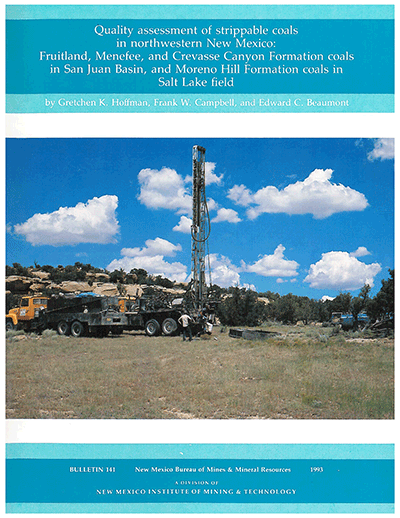
Bulletin 141—Quality assessment of strippable coals in northwestern New Mexico: Fruitland, Menefee, and Crevasse Canyon Formation coals in San Juan Basin, and Moreno Hill Formation coals in Salt Lake Field
By G. K. Hoffman, F. W. Campbell, and E. C. Beaumont, 1993, 84 pp, 22 tables, 45 figs.

During three years of drilling and sampling in the San Juan Basin, 524 coal core samples were collected from 149 drill sites on approximate 2 mi centers in the Fruitland, Menefee, Crevasse Canyon, and Moreno Hill Formations. Most of these drill sites were placed along the lines parallel to the Late Cretaceous shorelines in areas where thickest coals are at depths of about 200 ft. Eight drill sites in the Chacra Mesa field were drilled on a line perpendicular to the shorelines on 1 mi centers; the Moreno Hill Formation sites in the Salt Lake field and the Fruitland Formation in the Fruitland field were drilled on trends perpendicular to the Late Cretaceous shorelines.
The Fruitland Formation coals were from the Fruitland, Bisti, and Star Lake fields; the upper coal member of the Menefee Formation coals were from the Chacra Mesa and La Ventana fields; the Cleary Coal Member of the Menefee Formation coals were from the La Ventana, Chacra Mesa, San Mateo, and Standing Rock fields; and the remaining Menefee coals analyzed were from the Moreno field. Cleary-Gibson, Gibson, and Dilco Coal Member coals of the Crevasse Canyon Formation were cored and analyzed from the Gallup and Crownpoint fields, and coals from the Moreno Hill Formation were collected and analyzed from the Salt Lake field.
Significant aspects of chemistry, quality, coal rank, thickness trends, stratigraphic-depositional features, and petrographic composition are presented in this report. Petrographic analyses indicate a difference in maceral content between the Fruitland coals and the other older formations sampled. The Fruitland coals have a higher percentage of liptinite, in particular the resinite constituent of the liptinite group is much higher than for the Menefee and Crevasse Canyon coals. In general, the Fruitland coals have a higher hydrogen/volatile matter ratio which is in part influenced by the resinite content. The Moreno Hill Formation coals in the Salt Lake field have the highest inertinite content of all the formations sampled, indicating oxidation during coal development.
The Fruitland coals tend to be the most economically viable because of their thickness, relative continuity, and overall quality, albeit having a high ash yield. The Menefee Formation coals do not have the same degree of bed continuity or thickness as the Fruitland coals, but the ash yield is lower and the rank is equivalent to that of the Fruitland coals in the Bisti and Star Lake fields. Of the Menefee Formation coal fields investigated, the San Mateo field has the best economic potential because of the thickness of the coals and the low sulfur and ash. The Cleary-Gibson coals in the Gallup area have the greatest economic potential of the Crevasse Canyon fields examined. This coal-bearing sequence has both multiple coal beds and relatively thick coals. The Cleary-Gibson coals also have low ash and sulfur, which enhance their economic potential. Of the remaining fields drilled, the upper coal member Menefee coals in the La Ventana field and the Crevasse Canyon coals in parts of the Crownpoint field may be economic. The La Ventana upper member coals are relatively thick and have a low ash yield. In the Crownpoint field the coals are thickest in the area northwest of the town of Crownpoint and near Borrego Pass.
$12.00
Buy
Now
Also available as a free download.
Download
| File Name | Size | Last Modified |
|---|---|---|
| B141.pdf | 13.19 MB | 01/15/2021 01:24:35 PM |



